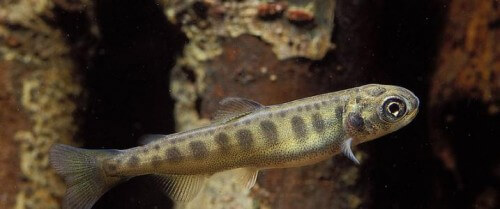The salmon fish can notice small changes in the magnetic field that surrounds them, and use them to navigate their way

A team of scientists has presented evidence of a correlation between the migration patterns of Pacific salmon and the Earth's magnetic field. This evidence may explain how the fish can navigate thousands of kilometers of water to find their river of origin.
This week, scientists confirmed the link between salmon and the magnetic field following a series of experiments at the Alsea Fisheries Research Center in Oregon. The researchers exposed hundreds of young Chinook salmon to different magnetic fields that exist at extreme latitudes at the edges of the ocean. The fish responded to this "simulated magnetic position" by swimming towards their reproductive center.
The research, funded by the Oregon Sea Foundation and the Oregon Department of Fish and Wildlife, will be published this month in an upcoming issue of the journal Current Biology.
"The particularly exciting thing about the experiment is that the fish we tested never left their farm and we know that their responses were not learned based on experience, but are passed down by inheritance," said Nathan Putman, a postdoctoral researcher from the Department of Fisheries and Wildlife at the University of Oregon, and the lead researcher of the article.
"These fish are programmed to know what to do before they reach the sea," he added.
To test the hypothesis, the researchers built a large device with copper wires running across it lengthwise and widthwise. By running currents through the wires, the researchers were able to create a magnetic field and determine both the strength of the field and its angle of inclination. They then put young salmon fingerlings, 5 centimeters long, into 20 liter tanks. After an acclimatization period, they monitored and photographed the direction in which the fry swam.
Fish exposed to the magnetic field characteristics of the northern limit of the chinook salmon's habitat in the ocean tended to swim south, while fish exposed to the characteristics of the southern limit of the chinook salmon's habitat tended to swim north. The fish were given a "sensation map" that determined where they were and in which direction to swim based on the magnetic field they sensed.
"The evidence is indisputable," said one of the authors of the article, David Knox, a senior scientist at the Fish Center at the University of Oregon: "The fish recognize and respond to the Earth's magnetic field, there can be no doubt about that."
"Not all the fish swam in the same direction," said Putman, "but there was a clear preference of the fish to swim away from the direction that the magnetic field told them was the wrong direction." According to the researchers, fish left near the breeding site, the Alesia River in Oregon, had a random sense of direction (those that were not shown any magnetic field), indicating that the fish's sense of orientation depends on changes in the magnetic field.
"What's really surprising is that these fish were exposed to the magnetic field we created for about eight minutes," Putman noted. "And the field wasn't even strong enough to deflect the compass needle. Putman added that the salmon should be particularly sensitive because the Earth's magnetic field is relatively weak. Because of this, it doesn't take much to interfere with their navigational abilities. "Many buildings contain electrical wires or reinforcing iron that may affect the direction of navigation of the fish in the early stage of their life cycle," say the researchers.
"Fish are raised in hatcheries where there are electric and magnetic effects," Knox said, "and some of them will encounter electric fields when they pass through dams used to generate electricity. When they reach the ocean, they may swim near structures or cables that can interfere with navigation. Does this have an effect? We don't know yet. "
On the same topic on the science website:
Putman said that even in nature there are factors that can disrupt their path, such as iron concentrations in the earth's crust, but the salmon have had to deal with this issue for thousands of years."
"The young salmon have to deal with their highest mortality when they first enter the ocean. " said Putman, "because they are required to adapt to a saltwater environment, find food, avoid predation and start their journey. Anything that makes them less efficient at navigating may cause them to take the wrong turn and end up in a desolate part of the ocean where they will starve.
However, Putman estimates that the magnetic field is not the only factor used by the salmon for navigation, "it is likely that they have a package of navigational aids that will help them reach the region of their object, perhaps also the angle of inclination of the sun, the sense of smell, and more."
For information on the Organ University website
